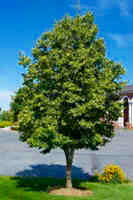Mon-Fri 9am - 5pm Mountain time
Common Hackberry vs Little Leaf Linden
Celtis occidentalis
Tilia cordata
NOT AVAILABLE THIS SEASON - MIGHT RETURN
The Common Hackberry is a medium-sized deciduous tree that resembles the American Elm but is immune to Dutch Elm Disease. They are versatile and can adapt to a variety of growing conditions.
It produces purple-red, berry-like fruit with a large seed in the center. Both the sweet flesh, which tastes similar to dates, and the crunchy seed are edible. The fruit remains on the tree throughout the winter, offering a valuable food source for birds and other wildlife.
The Common Hackberry can also be a great addition to a pollinator garden. The tree itself is a host for the larvae of several butterfly species and the flowers provide a source of pollen and nectar.
Little Leaf Linden is a large, deciduous shade tree that is native to Europe. The leaves are heart shaped with fine teeth on the margins. It has much smaller leaves than Large Leaf Linden.
Its small, fragrant yellow-green flowers are said to have medicinal properties and can also be used to make honey. Little leaf Linden is a great choice for a boulevard or large lot.

